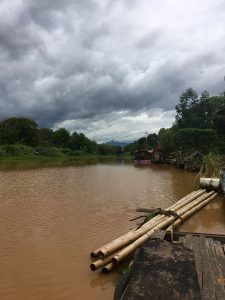Madison Jaschke and Maria Keeler
The natural environment of Thailand is vibrant, abundant and filled with patient energy. In order to understand and preserve that natural environment, focus cannot solely be placed on one area. Instead, it requires analysis encompassing nature’s interactions with humans. For example, an economy’s infrastructure and initiatives as well as community attitudes and knowledge affect the degree of exploitation for natural resources.
As a duo, Maria and Madison, we will address the human interactions influencing the Mekong River based on conversations with Director Krutee and Pe-Chak of the Mekong School in Chiang Khong. Among others, these men have dedicated themselves to spreading local knowledge about the river. We were moved by their passion for this Mother River, the 10th longest river in the world. It spans from southern China through 6 countries, finally flowing into the South China Sea. Over 70 million people are connected to the river, with many different ethnic communities and perspectives. The mighty Mekong River used to have a natural flow, whether it was the dry season that decreased the water level and provided nutrient-rich banks to be farmed on, or the rainy season that strengthened the currents and brought an abundant water supply for communities. The continuum of the Mekong has changed as a result of human influences affecting water levels, sediment distribution, fish spawning and livelihoods.
The largest human impacts on the river are the results of hydroelectric dams placed upstream, causing upsets for the countries and small communities downstream who are reliant on the river to sustain their families with food and an income. The dams, which are primarily implemented and controlled by China, have now created unpredictable patterns in water levels and flow that can fluctuate every 4-6 days. These changes impact communities that rely on the water level for agricultural use as well as base their fishing techniques off of.
Beyond unreliable water levels and turbidity, the dams have been detrimental to the river’s biodiversity. Fish populations have decreased and some species, including the Giant Mekong Catfish, are at risk of extinction. This limited supply directly impacts families who require fish for adequate protein intake. It also causes a trophic cascade within other species connected to fish, such as birds, aquatic insects and macrophytes.
The damages to biodiversity and human livelihoods are by no means local. Resources for one community influence a large web of interconnected communities far beyond the reaches of the river. China’s dam construction is based on their desire to improve their economy and develop a substantial energy and water supply. These motives overpower the need for conservation efforts. It is challenging as individuals to be heard against decisions made by a global superpower.
The first step toward resource preservation is knowledge. Most communities don’t understand the reasons behind the decreased fish populations and peripheral effects the dams are causing. The Mekong School is an excellent example of planting seeds for future change locally by traveling to schools and communities along the river in order to spread awareness. They are in the process of forming a coalition to prevent future dam construction. The Mekong River represents traditions, cultures, and ways of life, something that must not be forgotten in large-scale economic decisions. We return home with awareness and a desire for change. Although we reside far from the Mekong River, issues of water quality and community vitality apply across the globe.


“In a battle between elephants, the ants get squashed” -Thai proverb

 Thailand, for me, has been an opportunity for observation and comparison. I would like to stress that I am not focusing on judgmental comparisons, but instead constructive analyses between two very different cultures, the Thai and the American, in order to benefit from one another. In particular, my observations have been geared towards the natural environment and how the human built environment in working with it as well as against it. Looking out the window is where I notice the most, but also walking by and being among it all. I remember Acharn Linda saying, when we were all sharing our first impressions, that the Thai intentionally or even unconsciously maintain these “green spaces” throughout their infrastructure and within their built environments. I took notice to this as well, and I continue to see it as we travel around this country.
Thailand, for me, has been an opportunity for observation and comparison. I would like to stress that I am not focusing on judgmental comparisons, but instead constructive analyses between two very different cultures, the Thai and the American, in order to benefit from one another. In particular, my observations have been geared towards the natural environment and how the human built environment in working with it as well as against it. Looking out the window is where I notice the most, but also walking by and being among it all. I remember Acharn Linda saying, when we were all sharing our first impressions, that the Thai intentionally or even unconsciously maintain these “green spaces” throughout their infrastructure and within their built environments. I took notice to this as well, and I continue to see it as we travel around this country.